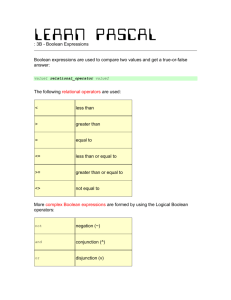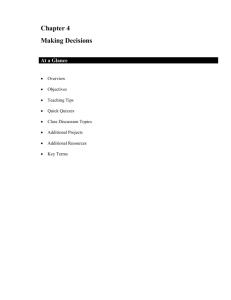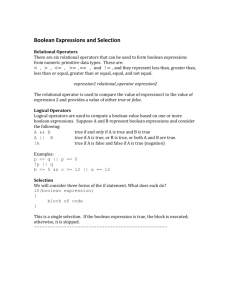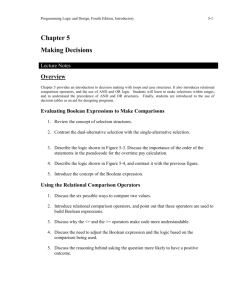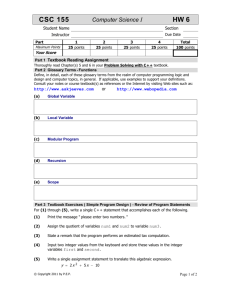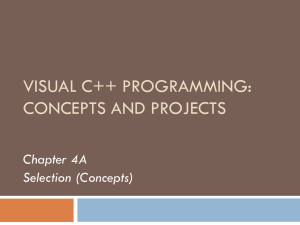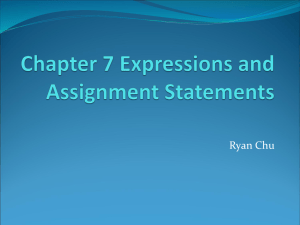Python Programming Decision Structures PPT
advertisement
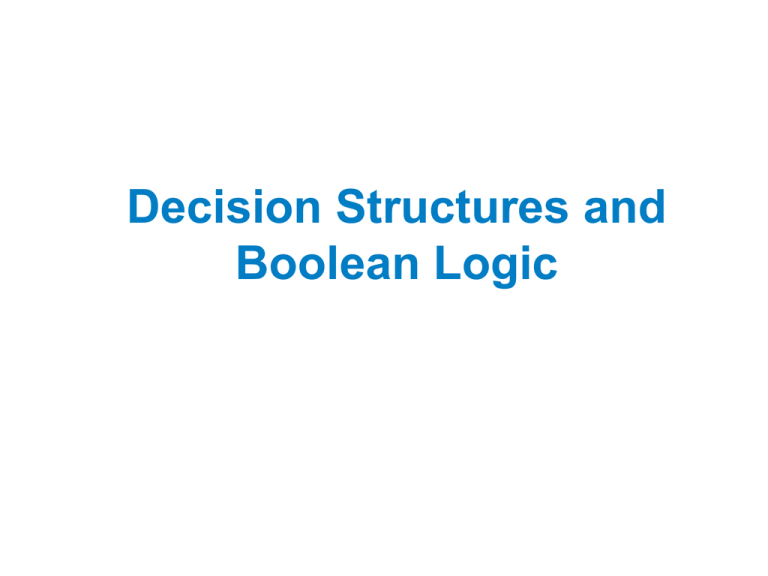
Decision Structures and Boolean Logic Topics The if Statement The if-else Statement Comparing Strings Nested Decision Structures and the ifelif-else Statement Logical Operators Boolean Variables The if Statement Control structure: logical design that controls order in which set of statements execute Sequence structure: set of statements that execute in the order they appear Decision structure: specific action(s) performed only if a condition exists Also known as selection structure The if Statement (cont’d.) In flowchart, diamond represents true/false condition that must be tested Actions can be conditionally executed Performed only when a condition is true Single alternative decision structure: provides only one alternative path of execution If condition is not true, exit the structure The if Statement (cont’d.) The if Statement (cont’d.) Python syntax: if condition: Statement Statement First line known as the if clause Includes the keyword if followed by condition The condition can be true or false When the if statement executes, the condition is tested, and if it is true the block statements are executed. otherwise, block statements are skipped Boolean Expressions and Relational Operators Boolean expression: expression tested by if statement to determine if it is true or false Example: a > b true if a is greater than b; false otherwise Relational operator: determines whether a specific relationship exists between two values Example: greater than (>) Boolean Expressions and Relational Operators (cont’d.) >= and <= operators test more than one relationship It is enough for one of the relationships to exist for the expression to be true == operator determines whether the two operands are equal to one another Do not confuse with assignment operator (=) != operator determines whether the two operands are not equal Boolean Expressions and Relational Operators (cont’d.) Boolean Expressions and Relational Operators (cont’d.) Using a Boolean expression with the > relational operator Boolean Expressions and Relational Operators (cont’d.) Any relational operator can be used in a decision block Example: if balance == 0 Example: if payment != balance It is possible to have a block inside another block Example: if statement inside a function Statements in inner block must be indented with respect to the outer block The if-else Statement Dual alternative decision structure: two possible paths of execution – One is taken if the condition is true, and the other if the condition is false Syntax: if condition: statements else: other statements if clause and else clause must be aligned Statements must be consistently indented The if-else Statement (cont’d.) The if-else Statement (cont’d.) Comparing Strings Strings can be compared using the == and != operators String comparisons are case sensitive Strings can be compared using >, <, >=, and <= Compared character by character based on the ASCII values for each character If shorter word is substring of longer word, longer word is greater than shorter word Comparing Strings (cont’d.) Nested Decision Structures and the if-elif-else Statement A decision structure can be nested inside another decision structure Commonly needed in programs Example: Determine if someone qualifies for a loan, they must meet two conditions: Must earn at least $30,000/year Must have been employed for at least two years Check first condition, and if it is true, check second condition Nested Decision Structures and the if-elif-else Statement (cont’d.) Important to use proper indentation in a nested decision structure Important for Python interpreter Makes code more readable for programmer Rules for writing nested if statements: else clause should align with matching if clause Statements in each block must be consistently indented The if-elif-else Statement if-elif-else statement: special version of a decision structure – Makes logic of nested decision structures simpler to write Can include multiple elif statements Syntax: if condition1 statements elif condition2 statements else statements The if-elif-else Statement (cont’d.) Alignment used with if-elif-else statement: if, elif, and else clauses are all aligned Conditionally executed blocks are consistently indented if-elif-else statement is never required, but logic easier to follow Can be accomplished by nested if-else Code can become complex, and indentation can cause problematic long lines Logical Operators Logical operators: operators that can be used to create complex Boolean expressions and operator and or operator: binary operators, connect two Boolean expressions into a compound Boolean expression not operator: unary operator, reverses the truth of its Boolean operand The and Operator Takes two Boolean expressions as operands Creates compound Boolean expression that is true only when both sub expressions are true Can be used to simplify nested decision structures Expression Value of the Truth table for the and operator Expression false and false false false and true false true and false false true and true true The or Operator Takes two Boolean expressions as operands Creates compound Boolean expression that is true when either of the sub expressions is true Can be used to simplify nested decision structures Expression Value of the Truth table for the or operator Expression false and false false false and true true true and false true true and true true Short-Circuit Evaluation Short circuit evaluation: deciding the value of a compound Boolean expression after evaluating only one sub expression Performed by the or and and operators For or operator: If left operand is true, compound expression is true. Otherwise, evaluate right operand For and operator: If left operand is false, compound expression is false. Otherwise, evaluate right operand The not Operator Takes one Boolean expressions as operand and reverses its logical value Sometimes it may be necessary to place parentheses around an expression to clarify to what you are applying the not operator Truth table for the not operator Expression Value of the Expression true false false true Checking Numeric Ranges with Logical Operators To determine whether a numeric value is within a specific range of values, use and Example: x >= 10 and x <= 20 To determine whether a numeric value is outside of a specific range of values, use or Example: x < 10 or x > 20 Boolean Variables Boolean variable: references one of two values, True or False Represented by bool data type Commonly used as flags Flag: variable that signals when some condition exists in a program Flag set to False condition does not exist Flag set to True condition exists Summary This chapter covered: Decision structures, including: Single alternative decision structures Dual alternative decision structures Nested decision structures Relational operators and logical operators as used in creating Boolean expressions String comparison as used in creating Boolean expressions Boolean variables
